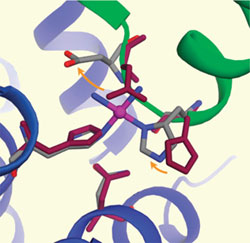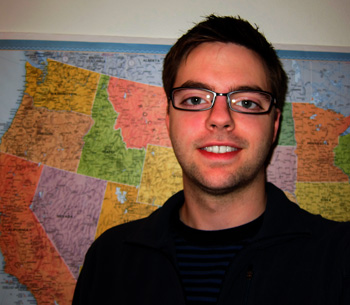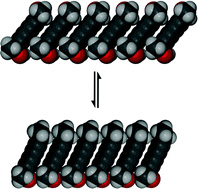 |
Two dumbbell-shaped polymorphs possess similar packing arrangements, but one shows anomalously anisotropic thermal expansion while the other does not.
Leonard J. Barbour and his team from the University of Stellenbosch, in South Africa and a co-worker from the Polish Academy of Sciences, have investigated these polymorphs further and discovered that by adjusting the molecular stacking angle by approximately 10° effectively disables the molecules’ ability to undergo thermal expansion. Fancy expanding your knowledge? Then why not download the ChemComm communication today and read all about the teams research results? This article is free to access until Friday 3rd June. |
To expand or not to expand?
Find out how 10 degrees can make all the difference for dumbell-shaped polymorphs
New copper complex offers easy access to complex structures
Chemists working at the University of Cambridge in the UK have discovered a new dicopper complex capable of forming diverse supramolecular structures.
The creation of supramolecular structures for a wide variety of uses has been something that chemists have pursued for years and, as such, new methods to access these structures are constantly sought. Jonathan Nitschke and colleagues are prominent figures in this field and have just reported a new copper complex that self assembles into larger architectures.

The team first assembled the copper complex and then showed they could modified it at two points. This is done either by substitution of solvent molecules with ligands capable of linking multiple complexes or by modifying the imine bonds. Using both these approaches and varying the ligands, it was possible to achieve the templated synthesis of 26- and 52-membered macrocycles. More complex assemblies that utilise this approach are currently being investigated.
Interested in finding out more? Then download Nitschke’s ChemComm article for free today. Also why not check out Dr Nitschke’s mini review and edge article form our sister journal Chemical Science?
Reactivity modulation in container molecules
Boris Breiner, Jack K. Clegg and Jonathan R. Nitschke
Chem. Sci., 2011, 2, 51-56
DOI: 10.1039/C0SC00329H, Minireview
Selective anion binding by a “Chameleon” capsule with a dynamically reconfigurable exterior
Yana R. Hristova, Maarten M. J. Smulders, Jack K. Clegg, Boris Breiner and Jonathan R. Nitschke
Chem. Sci., 2011, 2, 638-641
DOI: 10.1039/C0SC00495B, Edge Article
Call for communications: Artificial Photosynthesis
 We are delighted to announce a forthcoming web themed issue:
We are delighted to announce a forthcoming web themed issue:
Artificial Photosynthesis
Guest editor: Andrew Benniston (Newcastle University)
Submission deadline: 15th August 2011 EXTENDED TO 30TH SEPTEMBER!!
We are now welcoming submissions for this web theme, which will be a celebration of current achievements and future perspectives in this exciting field of research. Communications covering all aspects of the following areas are encouraged:
- new materials and photocatalysts for solar photochemistry
- hydrogen production and water splitting
- nitrogen and carbon dioxide functionalisation
- light harvesting and energy transfer
- electron transfer (tunnelling vs hopping)
- coupled proton/electron transfer
- long-range electron transport
- multi-electron redox processes
- bioinspired molecular systems
- nanostructures for solar energy usage
All manuscripts will undergo strict peer review and should be very important and conceptually significant in accord with the ChemComm mandate.
Publication of the peer-reviewed articles will occur without delay to ensure the timely dissemination of the work. The articles will then be assembled on the ChemComm website as a web-based thematic issue, to permit readers to consult and download individual contributions from the entire series.
Communications for this web theme can be submitted anytime from now until 30th September using our web submission system. Please add the phrase ‘artifical photosynthesis’ in the comments to the editor field.
New nerve agent sensor to join fight against terror
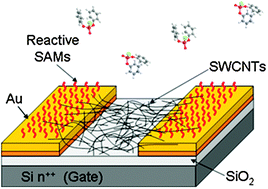
Organophosphorus (OP) compounds, such as sarin, are extremely neurotoxic compounds that have been used both in the battlefield and in terrorist attacks, including the Tokyo subway attack in 1995.
Current technologies for detecting OPs are not very practical, say Jean-Pierre Simonato (CEA Grenoble) and colleagues, so they’ve developed a new sensor based on carbon nanotube field-effect transistors.
Find out more in Simonato’s recently published ChemComm communication, free to download until 2nd June.
Anticancer drug found to cause zinc deficiency
Researchers now know why cisplatin, a leading cancer drug, causes zinc deficiency in patients
Cisplatin is responsible for abnormally low zinc levels in patients undergoing chemotherapy, say scientists in China and the UK.
Platinum-based compounds, like cisplatin, are the most widely used anticancer drugs in medicine. Research shows that up to 98 per cent of cisplatin binds to blood plasma proteins, particularly albumin. Until now, little has been known about the specific binding sites for platinum on albumin. ‘Since albumin plays a major role in cisplatin metabolism, a better understanding of its interactions with albumin should lead to more effective use of the drug and avoidance or control of side effects,’ says Peter Sadler from the University of Warwick, in the UK.
| Together with Fuyi Wang’s team from the Chinese Academy of Sciences in Beijing, Sadler used mass spectroscopy techniques to reveal that cisplatin reacts with recombinant human albumin (rHA) to create a cisplatin-rHA adduct. The platinum occupies zinc binding sites on the albumin, displacing the zinc, which causes hypozincemia (lack of zinc for metabolic processes) and hyperzincuria (increased zinc in urine).
Would you like to know more? Then read the full story on the Chemistry World website and download the ChemComm communication. |
Titanate cigarette filter
Significant reduction of harmful compounds in tobacco smoke
 Chinese researchers have shown for the first time that nanomaterials made from titanium dioxide (TiO2) can be used in cigarette filters to significantly reduce the amount of harmful chemicals inhaled by smokers. They say it offers a cheaper and safer alternative than using carbon-based nanomaterials and show potential for use in other filtering devices including gas masks and air purification systems.
Chinese researchers have shown for the first time that nanomaterials made from titanium dioxide (TiO2) can be used in cigarette filters to significantly reduce the amount of harmful chemicals inhaled by smokers. They say it offers a cheaper and safer alternative than using carbon-based nanomaterials and show potential for use in other filtering devices including gas masks and air purification systems.
Current cigarette filters are made from cellulose acetate, which absorbs some of the toxic and carcinogenic compounds present in tobacco smoke, including tar, nicotine, polycyclic aromatic hydrocarbons and tobacco-specific nitrosamines. In recent years, scientists have attempted to improve standard filters by adding nanomaterials, including carbon nanotubes or mesoporous silica, to capture more of these chemicals. But these experimental methods remain expensive and could pose unknown health risks.
ChemComm Emerging Investigator Lectureship – winner announced
Recognising and rewarding the very best emerging talent within the chemical sciences
 On behalf of the ChemComm Editorial Board, I am delighted to announce that Dr Scott Dalgarno (Heriot Watt University, Edinburgh, UK) has won the inaugural ChemComm Emerging Investigator Lectureship.
On behalf of the ChemComm Editorial Board, I am delighted to announce that Dr Scott Dalgarno (Heriot Watt University, Edinburgh, UK) has won the inaugural ChemComm Emerging Investigator Lectureship.
This annual award recognises an emerging scientist in the early stages of their independent academic career. The Editorial Board commended Dr Dalgarno’s contributions to the field of supramolecular chemistry, in particular the assembly and properties of calixarenes.
Dr Dalgarno will present his award lecture, entitled ‘Metal-Organic Calixarene Assemblies’, at the following locations:
- Challenges in Organic Materials & Supramolecular Chemistry (ISACS6), Beijing, China, 2nd-5th September 2011
- Chemical Science Symposium, Nanjing, China, 6th September 2011
- Zhejiang University, Hangzhou, China, 8th September 2011
For more details about these lectures, please contact ChemComm Editor, Robert Eagling.
To find out more about Dr Dalgarno’s research, read these recent ChemComm articles:
Calix[4]arene supported clusters: a dimer of [MnIIIMnII] dimers
Stephanie M. Taylor, Ruaraidh D. McIntosh, Christine M. Beavers, Simon J. Teat, Stergios Piligkos, Scott J. Dalgarno and Euan K. Brechin, Chem. Commun., 2011, 47, 1440-1442
Calixarene supported enneanuclear Cu(II) clusters
Georgios Karotsis, Stuart Kennedy, Scott J. Dalgarno and Euan K. Brechin, Chem. Commun., 2010, 46, 3884-3886
Magnetism in metal–organic capsules
Jerry L. Atwood, Euan K. Brechin, Scott J. Dalgarno, Ross Inglis, Leigh F. Jones, Andrew Mossine, Martin J. Paterson, Nicholas P. Power and Simon J. Teat, Chem. Commun., 2010, 46, 3484-3486
Top ten most accessed articles in March
This month sees the following articles in ChemComm that are in the top ten most accessed:-
Porous metal-organic frameworks as platforms for functional applications
Hai-Long Jiang and Qiang Xu
Chem. Commun., 2011, 47, 3351-3370, DOI: 10.1039/C0CC05419D, Feature Article
Surface modification of polyoxometalate host-guest supramolecular architectures: from metal-organic pseudorotaxane framework to molecular box
Xiaofei Kuang, Xiao-Yuan Wu, Jian Zhang and Can-Zhong Lu
Chem. Commun., 2011, 47, 4150-4152, DOI: 10.1039/C0CC05855F, Communication
Homogeneous catalysis using iron complexes: recent developments in selective reductions
Kathrin Junge, Kristin Schröder and Matthias Beller
Chem. Commun., 2011, 47, 4849-4859, DOI: 10.1039/C0CC05733A, Highlight
How easy are the syntheses of allenes?
Shichao Yu and Shengming Ma
Chem. Commun., 2011, 47, 5384-5418, DOI: 10.1039/C0CC05640E, Feature Article
Fe3O4 nanostructures: synthesis, growth mechanism, properties and applications
Ce Yang, Jiajia Wu and Yanglong Hou
Chem. Commun., 2011, 47, 5130-5141, DOI: 10.1039/C0CC05862A, Feature Article
Ordered mesoporous materials as adsorbents
Zhangxiong Wu and Dongyuan Zhao
Chem. Commun., 2011, 47, 3332-3338, DOI: 10.1039/C0CC04909C, Highlight
Mn12 single-molecule magnet aggregates as magnetic resonance imaging contrast agents
Yinglin Wang, Wen Li, Shengyan Zhou, Daliang Kong, Haishan Yang and Lixin Wu
Chem. Commun., 2011, 47, 3541-3543, DOI: 10.1039/C0CC03758C, Communication
A Covalent Organic Framework with 4 nm open pores
Mirjam Dogru, Andreas Sonnauer, Andrei Gavryushin, Paul Knochel and Thomas Bein
Chem. Commun., 2011, 47, 1707-1709, DOI: 10.1039/C0CC03792C, Communication
Selective CO2 adsorption in a flexible non-interpenetrated metal-organic framework
Tae Kyung Kim and Myunghyun Paik Suh
Chem. Commun., 2011, 47, 4258-4260, DOI: 10.1039/C0CC05199C, Communication
A colorimetric and fluorescent chemosensor for the detection of an explosive-2,4,6-trinitrophenol (TNP)
Yu Peng, Ai-Jiang Zhang, Ming Dong and Ya-Wen Wang
Chem. Commun., 2011, 47, 4505-4507, DOI: 10.1039/C1CC10400D, Communication
Why not take a look at the articles today and blog your thoughts and comments below.
Fancy submitting an article to ChemComm? Then why not submit to us today or alternatively contact us with your suggestions.
Antonio Echavarren joins the ChemComm Editorial Board
Editorial Office for organic chemistry and catalysis now open for submissions
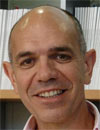 On behalf of the ChemComm Editorial Board, I am delighted to welcome Professor Antonio Echavarren as the new ChemComm Associate Editor for organic chemistry and catalysis.
On behalf of the ChemComm Editorial Board, I am delighted to welcome Professor Antonio Echavarren as the new ChemComm Associate Editor for organic chemistry and catalysis.
Professor Echavarren is Group Leader at the Institute of Chemical Research of Catalonia (ICIQ) in Tarragona, Spain. His research focuses on developing new catalytic methods based on the organometallic chemistry of transition metals as well as synthesing natural products and polyarenes.
Professor Echavarren’s editorial office is now open for submissions, welcoming urgent communications highlighting the latest advances in organic chemistry and catalysis.
Find out more about Professor Echavarren’s research on gold catalysis by reading these exciting articles:
A multipurpose gold(I) precatalyst
Mihai Raducan, Carles Rodríguez-Escrich, Xacobe C. Cambeiro, Eduardo C. Escudero-Adán, Miquel A. Pericàs and Antonio M. Echavarren, Chem. Commun., 2011, 47, 4893-4895
Mechanism of the gold-catalyzed cyclopropanation of alkenes with 1,6-enynes
Patricia Pérez-Galán, Elena Herrero-Gómez, Daniel T. Hog, Nolwenn J. A. Martin, Feliu Maseras and Antonio M. Echavarren, Chem. Sci., 2011, 2, 141-149
Are you an organic chemist based in North America? Submit your research to Michael Krische, ChemComm North American Associate Editor for organic chemistry.











